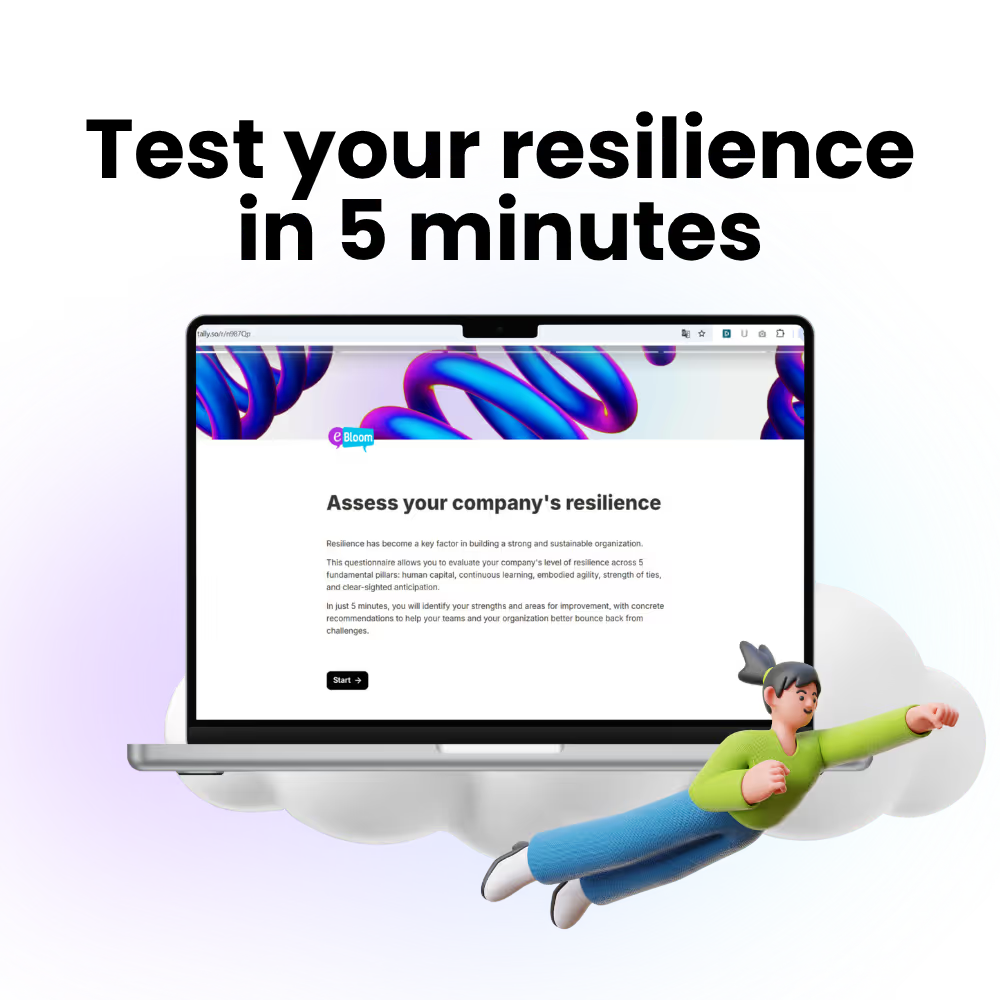
In this candid conversation, Laurence Vandresse, Head of Human Resources at Skipr, talks about the real challenges of managing HR in a company that’s all about pushing the boundaries of sustainable mobility. From keeping young, dynamic teams engaged to building a culture that feels authentic and lasting, Laurence opens up about the journey. She also shares how eBloom became a game-changer for them—helping Skipr measure, adapt, and improve their employee experience in ways that truly resonate with their workforce.
Let’s dive into the details of this insightful interview!
For those who want the complete insight, you can watch the full interview with Laurence below, where we cover everything from culture building to the importance of performance appraisals and how eBloom has transformed HR at Skipr.
We’ve also prepared a highlight reel for a quick overview of the key takeaways from our discussion. Watch the short version below:
Hello Margot. I'm Laurence, Human Resources Manager at Skipr for the past 2 years. So, what does Skipr do? We offer an application that enables companies to manage sustainable mobility. Our vision is really to make the world a better place in terms of mobility, and our mission is to support organizations in this transition towards much more sustainable mobility.
Well, challenges, that's a really good question. There are a lot of them, and I'll try to focus on those that are specific to HR at Skipr. The first is how to attract talent to our organization. This seems pretty basic, especially in a context of shortage, and mainly for tech profiles, which are very complicated to attract. Then, once we've attracted them, the challenge is to retain them. We have a lot of young people who really want to move around a lot. How can we keep them in our organization for as long as possible? For me, that's really the first challenge.
The second challenge, which is linked to the first, is that to keep them as long as possible, we need to have a very strong culture, very specific to Skipr. The challenge we face is therefore to constantly reflect on the corporate culture we have and want to have, how to strengthen it and how to involve everyone in the organization in creating this culture.
A third, very specific challenge has arisen thanks to the “Click and Bloom” that we do once a month. We realized that there was a real need to put in place performance appraisal, skills development, but also an opportunity for people to evolve within the organization. This raises the question of how, in a small start-up sometimes with limited resources, we can develop employees, evaluate them, and enable them to change function.
Linked to this, and very specific to our organization, is the fact that, to have a strong culture and guarantee performance and evolution, the role of managers is crucial. One of the other major challenges is therefore to know how we can develop and support managers in creating and reinforcing this culture.
A final challenge, among others, is the digitalization of the employee experience. These new generations demand that their experience be entirely digital, from start to finish. It's all about creating an optimal experience for these new employees. Those are the big challenges, but there are many more.
When I arrived 2 years ago, there was already a tool in place. It was a measurement tool used once a week, with the same questions over and over again. When I arrived, I realized that nobody was using it, and that it was very expensive. So we decided to stop using it. But we felt it was still important to measure, and we thought about the best solution for our needs. So, yes, there was already something in place, but it wasn't being used, was very expensive, and raised the question of anonymity (although the tool was indeed anonymous).
The ease of use for users, and the simplicity of installation and configuration for us, HR, who are in charge of the project, were decisive. But above all, the results are easy to see, very visual and simple to understand for everyone. There's a demand from employees to measure well-being, and eBloom lets us know what the “pulse” of the organization we work in is. This really motivated us to adopt the tool.
The results are very important to us, firstly to measure the “pulse” of the population and thus objectify perceptions. We really appreciate being able to see whether we're in the red, orange or green. This enables us to take preventive action, because prevention is better than cure. It also helps us to steer our HR actions, to be closer to employees' needs, to gather information, to get feedback and to know how we can improve.
In addition, there was a strong demand for anonymity during the surveys, but once the questions have been collected, we discuss with the teams to open up transparency. We find the right balance between anonymity and co-creating solutions with employees, in total transparency.
What impact does eBloom have on corporate culture?
Involving employees as much as possible in everything we do, whether it's our HR processes, working conditions, work environment or team buildings, contributes to building together a strong culture of transparency and collaboration. It's also a culture of continuous improvement, because we involve them directly.
It was interesting, because at first there was a rather negative perception of the tool. We took it step by step. The first thing was to explain to the managers why we wanted to implement this tool, what their role would be, and what the different stages would be. We also asked them for feedback to get them involved, as they're the ones who have to keep track of the people and actions arising from the “Click and Boom”. We decided to use it once a month, which seemed to suit our needs. We also allowed employees to fill it in over a week, as 2-3 days seemed too short. This worked well, and we saw an increase in the participation rate.
We also use eBloom to conduct surveys, and collect data in different ways and at different times. What's always interesting is to think about what we want to achieve, and choose the tool that best suits our needs.
We're delighted, because we have a participation rate of around 80% and a satisfaction rate also of around 80%. Initially, we were at 60-65%, and we've seen a steady positive trend since implementation. These figures are very important, especially for the CEO, who can present them to the board and demonstrate that 80% of employees are committed and satisfied with their work at Skipr.
They're very happy, because actions are taken based on the results measured by the tool. This reinforces their satisfaction, because they see that their feedback is taken into account. We in HR sometimes play the role of facilitators, transferring information to those who are responsible for processing it. We then come back to employees with information on actions taken, or those that will not be implemented. This transparent communication helps us to better manage expectations and avoid frustration.
One of the first actions I remember is that when we launched eBloom in a team, the participation rate was very low. We got together with the team to find out why. They mentioned doubts about anonymity, and we worked together to improve the process. One person offered to complete the survey at team meetings, separately and anonymously. This considerably increased the participation rate.
Another example concerns training. We used eBloom to identify training needs and organize sessions that were better adapted to employees' expectations. This has really helped us to improve our training offer.
For the moment, we're still in phase 1, where it's mainly HR who's piloting the tool. It doesn't take up too much of the managers' time, even though they have access to the results for their teams. We're planning a second phase where managers will take more control of the tool, as it's their role to look after the well-being of their teams. Then, we'd like to open up the tool to all employees, because we're all responsible for well-being at work.
Its simplicity of use and the ease with which you can understand the results. There are lots of visuals that make the data very accessible. What's more, eBloom is very customer-oriented: they listen to what you need and quickly adapt features based on feedback.
For us, eBloom is an HR management tool. It helps us to prioritize our objectives and determine which HR processes to work on, be it salary policy, working environment, teleworking or training plans. It also enables us to continue improving our actions.
Yes, we have closely followed up a question on skills development and assessment. Thanks to the implementation of the performance cycle and development plans, we have seen an increase in the satisfaction rate from 55% to 80%. This was a need expressed by employees, and we have implemented concrete actions to meet it.
The support is excellent. It's live, which is very useful for resolving technical problems quickly. As soon as we have a question, we receive an answer within 2 minutes, which is great for avoiding any bottlenecks.
Yes, without hesitation. Not only for its ease of use, but also for its ability to objectively measure subjective aspects such as employee well-being. It's a valuable tool for retention, talent attraction and internal communication. It also enables us to stand out from other companies, as the new generations attach great importance to well-being in the workplace.
I think it's important to first think about why you want to implement a tool like eBloom, and to define the well-being policy you want to adopt. Then, you need to explain to managers and the whole organization the reasons for this approach and how the tool will be used. It is also essential to train managers in the use of the tool, and to communicate transparently on the actions that will or will not be taken.
No, I think everything's been said. I'd just like to add that digitalization offers a great opportunity to track an employee's entire life cycle, from their first contact with the organization to their departure. This could make it possible to centralize all information on their well-being, development, performance, and even their relationships within the company.
Simplicity, measurement, well-being.

.avif)



